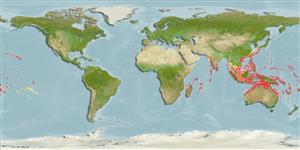Environment: milieu / climate zone / Tiefenbereich / distribution range
Ökologie
seewasser riff-verbunden; tiefenbereich 1 - 60 m (Ref. 27115), usually 25 - 60 m (Ref. 27115). Tropical; 24°C - 28°C (Ref. 27115); 35°N - 31°S, 30°E - 128°W
Indo-Pacific: East Africa, including the Mascarene Islands (Ref. 37792) to the Hawaiian, Marquesan, and Tuamoto islands, north to southern Japan, south to Lord Howe Island.
Size / Gewicht / Alter
Geschlechtsreife: Lm ? range ? - ? cm
Max length : 100.0 cm TL Männchen/unbestimmt; (Ref. 2334); max. veröff. Alter: 23 Jahre (Ref. 52229)
Rückenflossenstacheln (insgesamt) : 5; Rückenflossenweichstrahlen (insgesamt) : 28 - 29; Afterflossenstacheln: 2; Afterflossenweichstrahlen: 27 - 28. Plain brown or olivaceous in color, paler below; subadults with black caudal rays, narrow margins and white caudal filaments; pectoral fins with white distal margins (Ref. 3145).
Body shape (shape guide): fusiform / normal; Cross section: compressed.
Juveniles occur in clear, shallow lagoon reefs at depths as little as 1 m; adults rarely seen in less than 25 m, encountered off outer reef drop-offs in small schools (Ref. 30573, 48637). Benthopelagic (Ref. 58302). Feeds on large zooplankton during the day and shelter within the reef during the night; also benthic algae (Ref. 30573, 48637).
Life cycle and mating behavior
Geschlechtsreife | Fortpflanzung | Ablaichen | Eier | Fecundity | Larven
Spawn in pairs (Ref. 240).
Myers, R.F., 1991. Micronesian reef fishes. Second Ed. Coral Graphics, Barrigada, Guam. 298 p. (Ref. 1602)
IUCN Rote Liste Status (Ref. 130435: Version 2025-1)
Bedrohung für Menschen
Reports of ciguatera poisoning (Ref. 30298)
Nutzung durch Menschen
Fischereien: kommerziell; Aquarium: Kommerziell
Tools
Zusatzinformationen
Download XML
Internet Quellen
Estimates based on models
Preferred temperature (Ref.
123201): 23.5 - 28.3, mean 27.1 °C (based on 335 cells).
Phylogenetic diversity index (Ref.
82804): PD
50 = 0.5000 [Uniqueness, from 0.5 = low to 2.0 = high].
Bayesian length-weight: a=0.02399 (0.01396 - 0.04123), b=2.94 (2.79 - 3.09), in cm total length, based on LWR estimates for this species & Genus-body shape (Ref.
93245).
Trophic level (Ref.
69278): 2.1 ±0.09 se; based on food items.
Generation time: 5.2 ( na - na) years. Estimated as median ln(3)/K based on 1
growth studies.
Widerstandsfähigkeit (Ref.
120179): niedrig, Verdopplung der Population dauert 4,5 - 14 Jahre. (K=0.213; tmax=23).
Fishing Vulnerability (Ref.
59153): Moderate to high vulnerability (45 of 100).
🛈
Nutrients (Ref.
124155): Calcium = 25.8 [14.9, 48.4] mg/100g; Iron = 0.496 [0.250, 0.868] mg/100g; Protein = 18.8 [17.6, 19.9] %; Omega3 = 0.111 [0.068, 0.214] g/100g; Selenium = 45.7 [24.5, 84.5] μg/100g; VitaminA = 34.8 [10.7, 111.9] μg/100g; Zinc = 1.21 [0.83, 1.76] mg/100g (wet weight);
